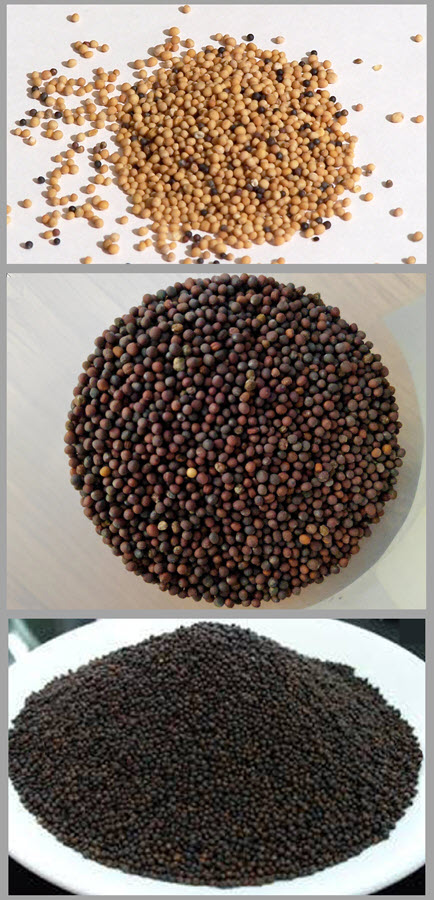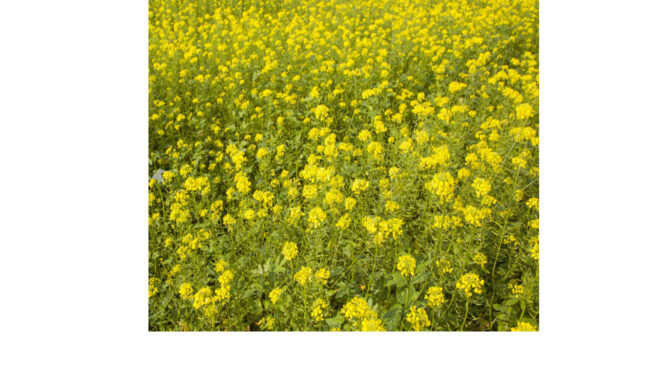Mustard seeds are condiments harvested from mustard plants and shrubs, grown all over the world. Major producers are India, Pakistan, Canada, Nepal, and Myanmar. Seeds are harvested from three types of mustard plant: black mustard, brown mustard and yellow/white mustard. Mustard seeds have been used for condiments for thousands of years. Black mustard is thought to be the seed mentioned by Jesus in the Parable of the Mustard Seed.

Black mustard seeds have a pungent spicy aroma and flavor. When fried in oil they produce a sweet and mild nutty taste. White/yellow mustard seeds have a mild flavor and are the most common seeds used to make American mustard.
Brown mustard seed are spicier and more “mustard-y” than yellow mustard seeds.
Mustard seeds are terrific to eat in any number of popular dishes including sandwiches, glazes, sauces, soups and marinades. And not surprisingly the taste of mustard ranges from sweet to spicy flavors which is why I enjoy eating mustard in virtually every salad dressing I make.
Mustard seeds, ground to add as a spice, provide a high percentage of daily nutrients, particularly Thiamine (B1), Folate, Niacin and Vitamin E. These seeds also provide significant amounts of the daily percentage mineral requirements for Iron, Magnesium, Phosphorus and Zinc.
Mixing mustard with cream is another delicious French cooking method to try. David Lebovitz, the cookbook author, uses mustard in his delightful new book called “My Paris Kitchen”. He recommends a large cooking pan be used to combine heavy cream with Dijon mustard that is sautéed on the top of the burner. Today’s dish is extra special when thighs, legs and breasts are cooked together in one large Spanish Paella pan, 15 inches in diameter. You also use the Paella pan with any number of other dishes for larger groups of people you are serving scrambled eggs, veal parmesan, stuffed eggplant, or mustard and creamy chicken like today’s recipe.
Ingredients
serves 6
- Large Spanish Paella pan ( 15-inch Paella Pan)
- 1/2 cup plus 3 tablespoon Dijon mustard
- 1 tbsp grainy mustard
- Fresh ground black pepper
- 1/4 Tsp kosher salt
- 3 chicken thighs, 3 chicken legs (each cut in half)
- Chicken breasts cut on the bias
- 1 cup diced thick cut bacon
- 1 tsp fresh Marjoram leaves
- 1 tbsp Mirin Sauce
- 1 small yellow onion, diced
- 2-3 tbsp heavy cream
- Fresh parsley, as a garnish
-Heat the covered skillet and add the thick cut bacon.
-Cook over medium high heat until brown all over. Remove from the pan and carefully drain on paper towels.
-Leave 1 tbsp of bacon fat in the pan, discard the rest of the oil and cook for 5 more minutes.
-Add some olive oil, thyme, diced onion and mirin into the pan, continue heating and then add the wine to the hot pan.
-Cover and cook until done by sticking a paring knife into the thigh bone. If it is still red continue cooking for a few more minutes. Do the same for the breast meat until done. Be sure the temperature reached 165 degrees when testing with cooking thermometer.
-Remove the pan from the heat and stir in the three tbsps. dijon mustard and mustard seeds along with a little water. Then sprinkle chopped parsley over the top and serve.
So good!

Send questions or your favorite recipes directly to azox@zoxkitchen.com. I look forward to hearing from you. Chef Alan
Description:
Enter a custom description of 30-50 words (based on an average word length of 5 characters).
If the description field is left blank, a description meta tag will be automatically generated from the excerpt or, if an excerpt has not been set, directly from the first paragraph of the content.
Keywords:
Enter keywords separated with commas.
If the keywords field is left blank, a keywords meta tag will be automatically generated from the post’s categories, tags, custom taxonomy terms and from the global keywords, if any such global keywords have been set in the plugin settings. In case you decide to set a custom list of keywords for this post, it is possible to easily include the post’s categories, tags and custom taxonomy terms in that list by using the special placeholders %cats%, %tags% and %terms% respectively.
Example: keyword1, keyword2, %cats%, keyword3, %tags%, keyword4
Title:
Enter a custom title to be used in the title HTML element of the page.
The %title% placeholder is automatically expanded to the current title of the content.
Note: more features for this metabox might be available in the Add-Meta-Tags settings. VisibilityPublish

